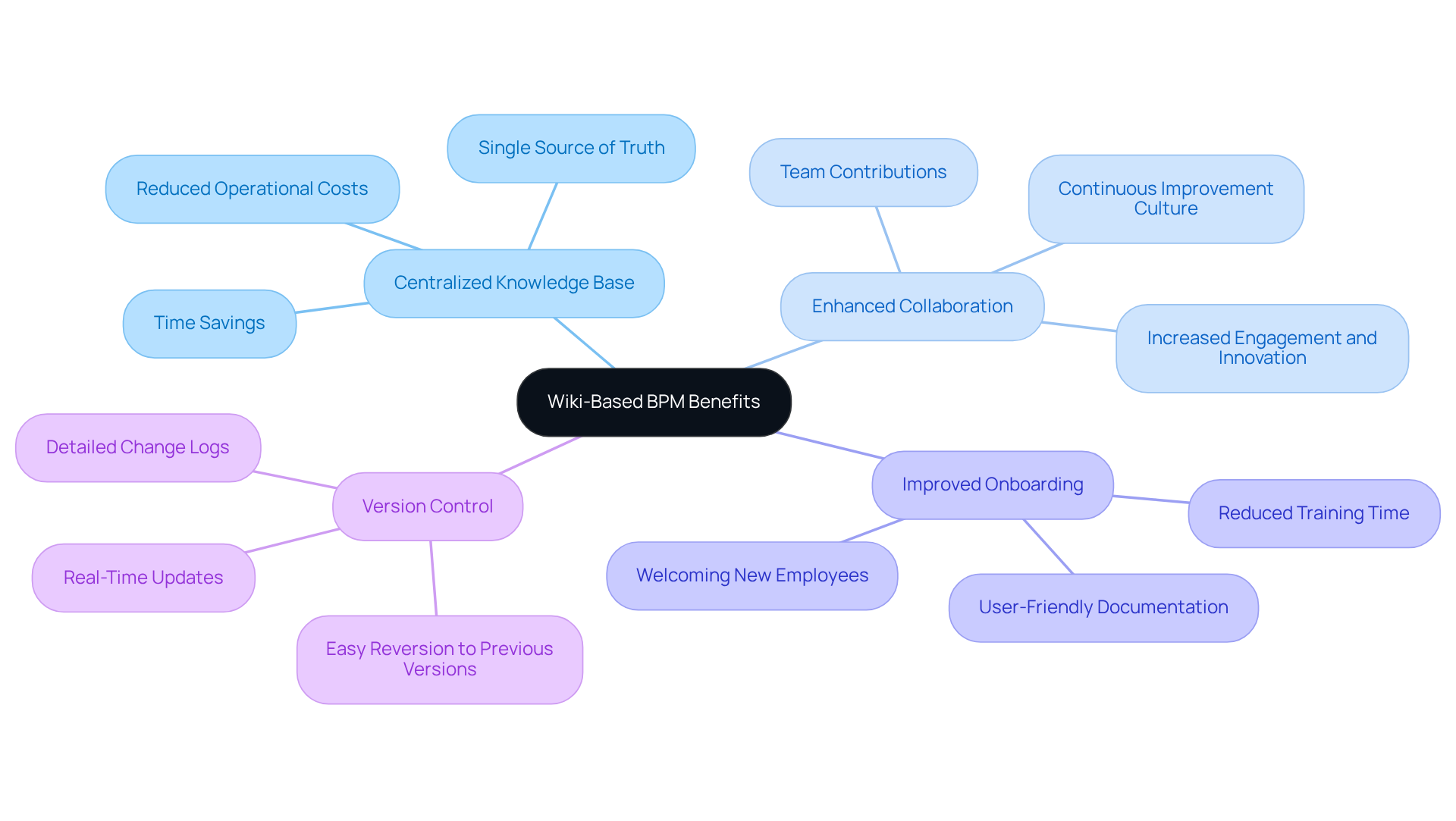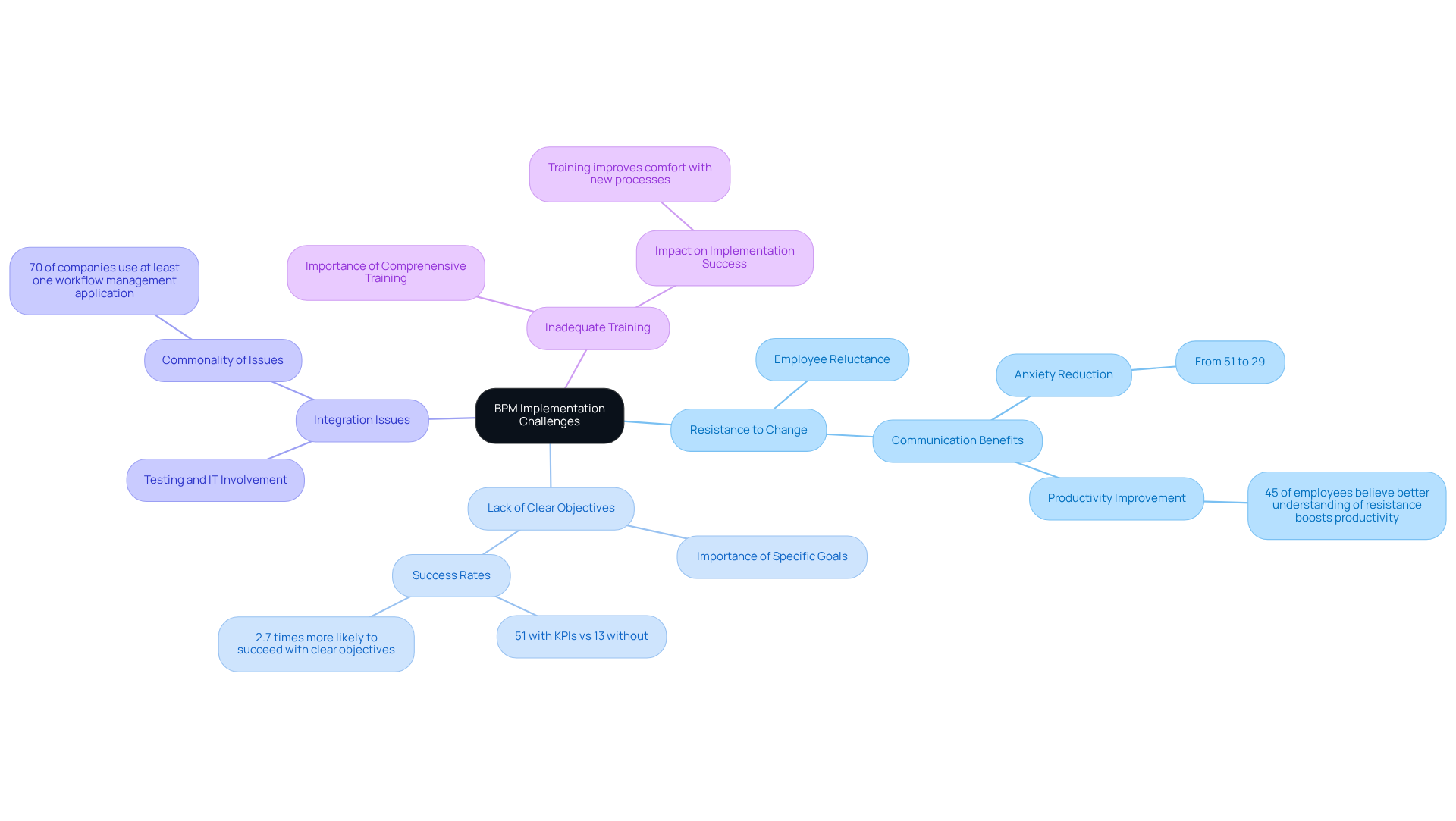
Overview
You might be wondering how to really get a grip on Wiki Business Process Management (BPM). Well, let’s break it down into four simple steps!
- First, it’s all about understanding the fundamentals of BPM.
- Next, we’ll explore the awesome benefits of using a wiki-based approach.
- After that, we’ll dive into how to implement a wiki effectively,
- and finally, we’ll tackle some common challenges you might face along the way.
Speaking of benefits, did you know that having a centralized wiki can totally enhance collaboration? It not only improves onboarding for new team members but also facilitates continuous improvement. This all leads to operational efficiency and, believe it or not, significant cost savings for organizations diving into BPM initiatives. So, are you ready to master BPM and see these benefits for yourself?
Key Highlights:
- BPM aims to improve organisational workflows through discovery, modelling, analysis, measurement, enhancement, optimization, and automation.
- Process mapping helps identify inefficiencies and enhances communication among team members.
- Process optimization can lead to performance improvements and significant cost savings, averaging around 20%.
- Continuous improvement ensures organisations adapt to market changes and remain competitive.
- 70% of organisations are engaged in BPM initiatives, with the market projected to reach $26.18 billion by 2028.
- A centralised wiki serves as a knowledge base, improving access to up-to-date documentation.
- Wikis enhance collaboration, boosting engagement and innovation within teams.
- User-friendly wikis improve onboarding by providing new hires with immediate access to necessary documentation.
- Version control in wikis helps maintain accurate information and allows for tracking changes.
- Key steps for implementing a wiki include selecting suitable software, defining structure, engaging stakeholders, training users, and monitoring updates.
- Common challenges in BPM implementation include resistance to change, lack of clear objectives, integration issues, and inadequate training.
Introduction
Mastering wiki business process management (BPM) is becoming increasingly essential as organizations strive for efficiency and adaptability in a rapidly evolving landscape. You might be wondering, what does this mean for you? This guide unveils the fundamental concepts and strategies that empower businesses to optimize workflows, enhance collaboration, and drive continuous improvement. But here’s the catch: with the promise of streamlined operations comes the challenge of effectively implementing these practices.
So, what are the key steps to overcome common obstacles and ensure successful integration? Let’s dive into it!
Understand Business Process Management (BPM) Fundamentals
Wiki business process management is all about making your organization's workflows better through a cycle of discovery, modeling, analysis, measurement, enhancement, optimization, and automation. You might be wondering what it takes to master BPM. Well, it requires a solid understanding of a few key concepts:
- Process Mapping: Imagine creating a visual representation of your workflows. This step is crucial for spotting inefficiencies and bottlenecks. Not only does effective workflow mapping clarify roles and responsibilities, but it also boosts communication among team members, leading to better collaboration and operational efficiency.
- Process Optimization: Think of techniques that improve performance and cut costs. Streamlining workflows can lead to significant savings—averaging around 20%! When organizations adopt organized systems, they often see a boost in employee morale and engagement. After all, who wouldn’t prefer focusing on value-added tasks instead of tedious manual work? A case study by Triaster even showed that improving just one frequently executed procedure could save a client over £300,000 each year. That’s a clear win for BPM!
- Continuous Improvement: This principle is all about the ongoing effort to enhance products, services, or methods. When organizations embrace a culture of continuous improvement, they’re better equipped to adapt to market changes and tech advancements, ensuring they stay competitive in the long run.
Now, let’s look ahead to 2025. The importance of workflow mapping in wiki business process management will be even more pronounced as companies increasingly rely on data-driven decision-making. Did you know that 70% of organizations are currently engaged in initiatives related to wiki business process management? Plus, the market for wiki business process management is projected to hit $26.18 billion by 2028! Understanding these fundamentals is key to effectively implementing wiki business process management strategies that drive operational excellence and ensure customer satisfaction. And here’s a fun fact: according to Gartner, implementing BPM can boost project success rates by a whopping 70%! That really highlights its critical role in modern business.

Explore Benefits of Wiki-Based BPM for Operations
You might be wondering how implementing a wiki business process management (BPM) system could really help your organization. Well, let’s dive into some of the fantastic advantages it offers!
First off, consider the Centralized Knowledge Base. A wiki serves as your go-to source for all things process-related. This means no more digging through scattered documents or outdated emails. Everyone on your team can access the latest updates, which is key to keeping things running smoothly.
Now, let’s talk about Enhanced Collaboration. Wikis are all about teamwork! They allow group members to jump in, contribute, and edit documentation with ease. This creates a culture of continuous improvement where sharing knowledge becomes second nature. Organizations that embrace this collaborative spirit often see a boost in engagement and innovation. Plus, with SowFlow, creating standard operating procedures (SOPs) is a breeze, saving you time and increasing productivity.
When it comes to Improved Onboarding, new hires can hit the ground running by accessing user-friendly documentation. This not only cuts down on training time but also makes new employees feel welcomed and supported from day one. Thanks to SowFlow’s intuitive interface, teams can whip up user guides in no time, ensuring that onboarding materials are always up-to-date and relevant.
Let’s not forget about Version Control. Wikis keep a detailed log of changes, so teams can track updates and revert to earlier versions if necessary. This is crucial for making sure everyone is on the same page with the most accurate information. With SowFlow, you can update documentation on the fly, so your team can quickly adapt to any changes in procedures or policies.
By leveraging wiki business process management, your organization can create a more agile and responsive environment, which ultimately leads to better productivity and lower operational costs. SowFlow’s innovative documentation solutions simplify standardization and enhance knowledge sharing across teams, making it an invaluable resource for operations managers. So, why not explore how a wiki can transform your documentation process today?

Implement a Wiki for Effective BPM Integration
Are you looking to successfully implement a wiki business process management (BPM) integration? Here are some steps you might find helpful:
- Select the Right Wiki Software: First off, you’ll want to choose a platform that fits your organization's needs. Think about user-friendliness, scalability, and how well it integrates with your existing tools. A well-chosen wiki can save your staff a ton of time—studies show that searching for information can eat up nearly 20% of their workweek!
- Define Structure and Guidelines: Next, let’s talk structure. It’s super important to establish a clear organizational setup for your wiki. Categorizing different processes and creating solid guidelines for content creation and editing will not only help with navigation but also allow your employees to quickly find what they need, boosting productivity.
- Engage Key Stakeholders: You might be wondering how to get everyone on board. Involve team members from various departments in developing the wiki. This collaboration brings in diverse perspectives and ensures comprehensive coverage of processes. Plus, it fosters a culture of knowledge sharing and continuous improvement. Companies that embrace this collaborative spirit often see better communication and teamwork.
- Train Users: Now, let’s dive into training. Conducting sessions to familiarize staff with the wiki's features is crucial. Encouraging everyone to participate actively is key to a successful corporate wiki. When employees feel empowered to use the platform for documentation and collaboration, it can really make a difference.
- Monitor and Update Regularly: Finally, don’t forget about accountability! Designate someone to manage the wiki and keep content fresh and relevant as methods evolve. Regular updates and monitoring are essential to avoid information stagnation, which can lead to confusion and inefficiencies.
By following these steps, you can seamlessly incorporate wiki business process management into your BPM strategy. It’s all about improving collaboration and knowledge sharing while optimizing your documentation methods. So, are you ready to get started?

Troubleshoot Common BPM Implementation Challenges
You might be wondering about the common challenges in wiki business process management implementation. Let's dive into some key hurdles you might face:
- Resistance to Change: One of the biggest roadblocks to successful BPM adoption is the reluctance of employees to embrace new processes. To ease this, it’s super important to communicate the benefits of BPM clearly and get your team actively involved in the implementation. Research shows that organizations that focus on open communication can cut down employee anxiety about change from 51% to 29%. Plus, 45% of employees think that if leaders understood their resistance to change better, it could really boost productivity. So, effective communication is key!
- Lack of Clear Objectives: Having clear BPM goals is crucial for keeping everyone focused and aligned. When organizations set specific objectives, they’re much more likely to see successful outcomes. In fact, companies that track key performance indicators (KPIs) during change implementation enjoy a success rate of 51%, while those that don’t only hit 13%. And get this: companies that prioritize clear objectives increase their chances of success in transformation efforts by 2.7 times! It really highlights how vital it is to set those clear goals.
- Integration Issues: Integrating BPM tools with existing systems can be tricky. To tackle this, make sure to conduct thorough testing and involve your IT teams early on to identify any potential conflicts. This proactive approach can really streamline integration and boost overall efficiency. Interestingly, 70% of companies surveyed use at least one application for workflow management, which shows just how common these integration challenges are.
- Inadequate Training: Comprehensive training is essential to ensure everyone feels comfortable with new processes and tools. Organizations that invest in training not only empower their staff but also significantly improve their chances of successful BPM implementation. As Dr. Jeremy Pollack points out, workplace training and development are crucial for equipping employees to tackle modern challenges.
By addressing these challenges head-on, you can greatly enhance your organization’s chances of successful wiki business process management implementation, resulting in better efficiency and lower operational costs. So, what do you think? Ready to tackle these issues together?

Conclusion
Mastering wiki business process management (BPM) is crucial for organizations looking to boost their operational efficiency and adaptability. You might be wondering how that works. By tapping into process mapping, optimization, and continuous improvement, businesses can streamline their workflows and foster a collaborative culture that drives success. Plus, integrating a wiki-based BPM system not only centralizes knowledge but also encourages teamwork, leading to better performance and cost savings.
Throughout this article, we’ve explored some key insights into the benefits of wiki BPM. Centralized knowledge bases help eliminate the chaos of scattered information, while enhanced collaboration sparks engagement and innovation among team members. And let’s not forget about effective onboarding processes and robust version control; these ensure that everyone has access to the most accurate information, creating a more agile and responsive organizational environment.
The importance of adopting wiki-based BPM really can’t be overstated. As organizations navigate the complexities of today’s business landscape, embracing these strategies will empower them to adapt and thrive. By tackling common implementation challenges and nurturing a culture of continuous improvement, teams can unlock the full potential of their BPM initiatives. So, why wait? Now is the perfect time to explore how a wiki can transform your organization’s documentation processes and drive operational excellence.
Frequently Asked Questions
What is Business Process Management (BPM)?
Business Process Management (BPM) is the practice of improving an organization's workflows through a cycle of discovery, modeling, analysis, measurement, enhancement, optimization, and automation.
What is process mapping in BPM?
Process mapping involves creating a visual representation of workflows to identify inefficiencies and bottlenecks. It clarifies roles and responsibilities and enhances communication among team members, leading to better collaboration and operational efficiency.
How does process optimization benefit organizations?
Process optimization employs techniques that improve performance and reduce costs, potentially leading to savings of around 20%. It enhances employee morale and engagement by allowing them to focus on value-added tasks rather than tedious manual work.
What is the principle of continuous improvement in BPM?
Continuous improvement is the ongoing effort to enhance products, services, or methods, enabling organizations to adapt to market changes and technological advancements, thus maintaining competitiveness over time.
What is the projected market size for BPM by 2028?
The market for Business Process Management is projected to reach $26.18 billion by 2028.
What percentage of organizations are engaged in BPM initiatives?
Currently, 70% of organizations are involved in initiatives related to Business Process Management.
How can BPM impact project success rates?
Implementing BPM can boost project success rates by as much as 70%, highlighting its critical role in modern business operations.
👍
What others are liking
5 Steps to outline your ideal documentation structure
5 MINS READ
Where to start the your journey of mapping out your ideal documentation structure, aligning it with the very heartbeat of your organization?
Defining a winning level of detail in your process
3 MINS READ
What is too much detail, and what is too little? This article described in that winning level detail about what detail is enough.





